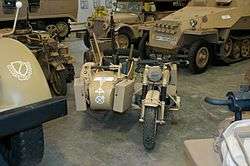BMW R75
- For the 1970s 750 cc motorcycle see BMW R75/5
 | |
| Manufacturer | BMW |
|---|---|
| Production | 1941–1946 |
| Class | Motorcycle/sidecar combination |
| Engine | 745 cc flat-twin (OHV)[1] |
| Bore / stroke | 78 mm × 78 mm (3.1 in × 3.1 in)[1] |
| Power | 26 hp (19 kW)[1] |
| Weight |
420 kg (930 lb) (dry) |

The BMW R75 is a World War II-era motorcycle and sidecar combination produced by the German company BMW.
In the 1930s BMW were producing a number of popular and highly effective motorcycles. In 1938 development of the R75 started in response to a request from the German Army.
Preproduction models of the R75 were powered by a 750 cc side valve engine, which was based on the R71 engine. However it was quickly found necessary to design an all new OHV 750 cc engine for the R75 unit. This OHV engine later proved to be the basis for subsequent post-war twin BMW engines like the R51/3, R67 and R68.
The third side-car wheel was driven with an axle connected to the rear wheel of the motorcycle. These were fitted with a locking differential and selectable road and off-road gear ratios through which all four and reverse gears worked. This made the R75 highly manoeuvrable and capable of negotiating most surfaces. A few other motorcycle manufactures, like FN and Norton, provided an optional drive to sidecars.
The BMW R75 and its rival the Zündapp KS 750 were both widely used by the Wehrmacht in Russia and North Africa, though after a period of evaluation it became clear that the Zündapp was the superior machine. In August 1942 Zündapp and BMW, on the urging of the Army, agreed upon standardization of parts for both machines, with a view of eventually creating a Zündapp-BMW hybrid (designated the BW 43), in which a BMW 286/1 side-car would be grafted onto a Zündapp KS 750 motorcycle. They also agreed that the manufacture of the R75 would cease once production reached 20,200 units, and after that point BMW and Zündapp would only produce the Zündapp-BMW machine, manufacturing 20,000 each year.
Since the target of 20,200 BMW R75's was not reached, it remained in production until the Eisenach factory was so badly damaged by Allied bombing that production ceased in 1944. A further 98 units were assembled by the Soviets in 1946 as reparations.
However the standardisation programme meant that machines that were produced by BMW and Zündapp used 70% of the same components. This simplifies the supply of spare parts for these vehicles, many of which are still in the hands of historic motorcycle enthusiasts. These vehicles are still highly desirable as collector's items because of their complex and durable technology, and are correspondingly expensive. A well-restored R75 can be still used for everyday purposes, on or off-road without problems.
During World War 2 the Soviet Union quietly purchased five units via Swedish intermediaries to study and subsequently build their own version, the M-72, which Stalin approved for production.
In 1954 a small number of modified R75 models were produced at Eisenach (then in Soviet-controlled East Germany) for testing under the designation AWO 700, but were not put into full production.
The success and reliability of the shaft-driven R75 during the war led to the US Army requesting that Harley-Davidson produce a similar shaft-driven cycle for American troops. This led to Harley producing their first ever shaft-driven model, the Harley-Davidson XA, which was a near duplicate of the R75.[2]
See also
References
- 1 2 3 "BMW R75 sidecar unit specifications". Phil Hawksley's BM Bikes. Retrieved 6 December 2009.
- ↑ Motorcycle Hall Of Fame Museum
- Piekalkiewicz, Janusz (1991). BMW Motorcycles in World War II: R12/R75. Schiffer Military History. ISBN 978-0-88740-306-4.
External links
| Wikimedia Commons has media related to BMW R75. |
| ||||||||||||||||||||||||||||||||||||||||||||